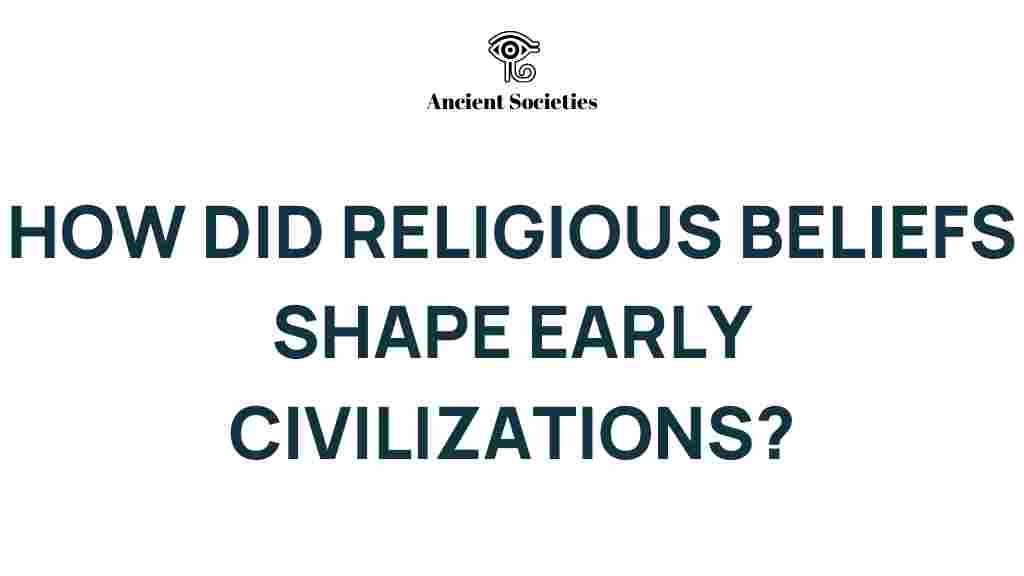Unraveling the Threads: How Religious Beliefs Shaped Early Civilizations
Throughout history, the development of early civilizations has been intricately tied to the religious beliefs that shaped their cultures and societies. From the ancient practices of the Sumerians to the spiritual traditions of the Egyptians, understanding how these belief systems influenced civilization development provides insight into the dynamics of human history. This article explores the various ways in which religious beliefs have molded early civilizations and their lasting impacts on culture and society.
The Foundation of Early Civilizations
Early civilizations emerged in fertile areas, where agriculture allowed for the establishment of stable communities. However, the rise of these societies was not solely due to economic factors; religious beliefs played a crucial role in their development.
- Creation of Social Structures: Religious beliefs often dictated the social hierarchy, with priests and religious leaders holding significant power.
- Unifying Ideologies: Shared belief systems fostered unity among diverse groups, allowing for cooperation and collaboration.
- Rituals and Ceremonies: The practice of rituals strengthened community bonds and provided a shared cultural identity.
Religious Beliefs in Ancient Practices
The ancient practices of various civilizations were heavily influenced by their spiritual beliefs. From the worship of deities to the veneration of ancestors, these practices played a pivotal role in daily life.
- Polytheism: Many early civilizations, such as the Greeks and Romans, practiced polytheism, believing in multiple gods who governed different aspects of life.
- Animism: Some cultures believed that natural objects and phenomena possessed spirits, leading to a deep respect for the environment.
- Ritual Sacrifices: In various societies, sacrifices were made to appease gods, reflecting the importance of spirituality in maintaining harmony.
The Influence of Religion on Art and Architecture
Religious beliefs profoundly influenced the art and architecture of early civilizations. Temples, monuments, and artworks were created to honor the divine and reflect spiritual values.
- Temples and Shrines: Structures such as the ziggurats of Mesopotamia and the pyramids of Egypt were built to worship gods and serve as burial sites for rulers.
- Symbolism in Art: Religious themes dominated artistic expression, with depictions of gods, myths, and spiritual journeys.
- Cultural Heritage: These artistic endeavors contributed to a civilization’s identity and legacy, influencing future generations.
The Role of Belief Systems in Governance
Governance in early civilizations was often intertwined with religious beliefs. Leaders were frequently seen as divine or chosen by the gods, which legitimized their authority.
- The Divine Right of Kings: In many societies, rulers claimed their right to govern was granted by the divine, creating a strong bond between religion and political power.
- Law and Morality: Religious texts often served as the foundation for legal systems, dictating moral behavior and societal norms.
- Conflict and Conquest: Religious motivations frequently fueled wars, as civilizations sought to spread their beliefs or assert dominance over others.
Spirituality and Community Life
Spirituality was central to community life in early civilizations. The collective practice of religion fostered a sense of belonging and purpose among individuals.
- Festivals and Celebrations: Religious festivals brought communities together to celebrate, reinforcing social ties and cultural identity.
- Moral Frameworks: Shared beliefs provided guidelines for behavior, influencing community interactions and individual choices.
- Support Systems: Religious institutions often served as support networks, assisting the needy and fostering social responsibility.
The Legacy of Early Civilizations
The legacy of early civilizations continues to influence modern society. Many contemporary belief systems can trace their roots back to ancient practices, highlighting the enduring impact of religious beliefs on culture and society.
- Philosophical Foundations: Early philosophical thoughts were often intertwined with religious ideas, shaping moral and ethical frameworks.
- Architectural Inspirations: Modern architecture still draws from ancient designs, reflecting the lasting beauty of spiritual structures.
- Continued Spiritual Practices: Many modern religions retain elements of ancient belief systems, showcasing the evolution of spirituality.
Conclusion
Religious beliefs have undeniably shaped early civilizations, influencing every aspect of culture and society. From governance and social structures to art and community life, spirituality played a fundamental role in civilization development. As we explore the history of these ancient practices, we gain a deeper understanding of how belief systems continue to resonate in our modern world.
For more insights into the connections between religion and society, check out this detailed analysis. To delve further into the impact of spirituality on culture, visit this external resource.
This article is in the category History and created by AncientSocieties Team
